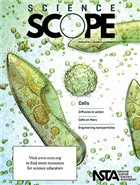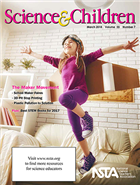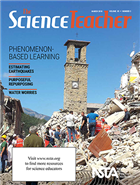Ideas and inspiration from NSTA’s March 2018 K-12 journals
By Mary Bigelow
Posted on 2018-03-08
Regardless of what grade level or subject are you teach, as you skim through the article titles, you may find ideas for lessons that would be interesting your students or the inspiration to adapt/create your own.
All three journals this month include recommendations for the Best STEM Books for Students K–12.
 Science Scope – Cells
Science Scope – Cells
From the Editor’s Desk: Sparking Student Interest in Hidden Worlds …cells are the essence of life, and to understand cells is to begin to understand ourselves…Knowledge of cells and the life processes they conduct is the basis for understanding tissues, organ systems, genetics, and the brain…Cells’ impact on the human body therefore warrants more than a circumspect lesson in the middle school classroom.
Articles in this issue that describe lessons include a helpful sidebar (“At a Glance”) documenting the big idea, essential pre-knowledge, time, and cost; many follow a 5E format. The lessons also include connections with the NGSS, and many include examples of student work, assessments, and classroom materials.
- Could “The Martian” Really Have Grown Potatoes for Food? is the context for an investigation into how amounts of soil, nutrients, and water can limit plant growth.
- Mars is also the context for Cells on Mars as students compare the similarities and differences between plant and animal cells working with authentic tissue samples.
- Engineering Nanoparticles for the Body includes a 5E lesson on creating and using models (and their knowledge of the circulatory system and blood vessels) to determine the best way to deliver a nanoparticle in the body
- Go beyond a replica craft project to Cell Modeling Students Can Really Get Into Students create a model to explain and explore cell structure and diversity and display their models to others in a classroom museum. Photos of models are included.
- Classic Lessons 2.0: Diffusion in Action describes an activity that helps explain the cell surface area to volume relationship.
- In addition to the structure of a cell, activities address the processes that take place in the cell. Integrating Technology: Mapping Digital Game Analogies to Science Instruction looks at photosynthesis.
- Citizen Science: iNaturalist suggests how to incorporate the application with a “bioblitz” survey of living species in an area.
- If your students struggle with the Claim-Evidence-Reasoning Teacher To Teacher: Scaffolds for Scientific Explanations has some suggestions and an organizer to assist students.
These monthly columns continue to provide background knowledge and classroom ideas:
- Scope on the Skies: Motions of the Earth and Beyond
- Listserv Roundup: Interactive and Digital Notebooks in the Science Classroom
- Disequilibrium: Sensory Illusions (5E lesson)
- Science For All: Making Science Memorable
For more on the content that provides a context for projects and strategies described in this issue, see the SciLinks topics Animal/Plant Cells, Biodiversity, Biomedical Engineer, Cell Structures, Cell Theory, Circulatory System, Concept Maps, Diffusion, How Do Plant and Animal Cells Differ?, Limiting Factors, Nanotechnology, Organelle, Photosynthesis, Plant Growth, Senses, Stimuli
Keep reading for Science and Children and The Science Teacher

Science & Children – The Maker Movement
Editor’s Note: Making Sense of Makerspaces: Tinkering…allows students to play around with the materials and objects they encounter to determine their properties and how they work together. But students should then have the opportunity to make something out of the materials they have interacted with and understand…Ultimately, teachers should strive to have students create something that solves a problem or supports the accomplishment of a goal…Today, makerspaces are for everyone, each bringing to it their own experiences and building their science and engineering practices and understanding through tinkering, making, and engineering.
The lessons described in the articles have a chart showing connections with the NGSS and many include classroom materials, illustrations of student work, and photographs of students at work.
Check out the February 2017 issue of Science Scope, for more ideas on the Maker Movement.
- Guest Editorial: Elementary Engineering: What Is the Focus? This editorial address concerns whether children can (or should) engage in the engineering process Children have their own creative ideas to build and are intrinsically compelled to act upon them. In their process of construction, children grapple with systems thinking, growing to understand that the effect of changing one part of the system may have unintended consequences for the performance of another. They problem solve and often communicate with peers to collaborate in their perseverance to be successful. In the process, children have the opportunity to wrestle with their ethical use of materials and navigate social relationships.
- School Maker Faires “showcase student work and work-in-progress to families and the community while also providing opportunities for attendees to make along-side students and teachers.” The article includes tables showing an alignment between maker activities and NGSS, suggestions for organizing a faire, and photos of several maker stations.
- Plastic Pollution to Solution includes a 5E unit that focuses on taking action on ocean pollution. Students share photos of their innovations.
- The teacher-authors of Mars Mission Specialist describe how they updated a model-rocket building lesson into a maker experience with a real-life context in design and problem-solving.
- 3D Pit Stop Printing incorporates the car design process with problem-solving, design, and manufacturing. They also share lessons learned and suggestions.
- Ready, Set, FLOW! traces the development of a classroom aquarium into a working aquaponics system designed and maintained by students.
- The Early Years: Open-Ended Maker Projects includes ideas for updating crafts to opportunities for young students to design and make their own structures.
- Formative Assessment Probes: Uncovering “Maker” Ideas About Sound suggests way to make sure that students understand what they are learning during a maker project.
- In addition to recommending trade books, Teaching Through Trade Books: The Force Is With You (or Against You) has two 5E lessons related to forces: Playground Physics (K-2) and Toying Around With Force, Motion, and Energy (3-5).
- A student’s background should not determine whether they participate in maker projects. Methods and Strategies: Equity and the Maker Movement highlights “five ways that we have found community ethnography as pedagogy for STEM-rich making to yield powerful outcomes for children.”
These monthly columns continue to provide background knowledge and classroom ideas:
- The Poetry of Science: Let’s Make a Robot
- Teaching Teachers: Designing an NGSS Learning Pathway
- Science 101: Why Do Helicopters Always Have Two Blades, and How Does That Help Cats?
- Science 102: A Faucet Phenomenon
For more on the content that provides a context for projects and strategies described in this issue, see the SciLinks topics Engineering Structures, Forces and Motion, Oceans, Planets, Robots, Rocket Technology, Solutions to Pollution Problems, Sound, Space Exploration, Water Pollution and Conservation
 The Science Teacher – Phenomenon-Based Learning
The Science Teacher – Phenomenon-Based Learning
Editor’s Corner: Phenomenal Science: In PhBL classrooms, instruction begins with an interesting phenomenon that serves as the anchor for learning, providing context and relevance. Students explore, investigate, and explain the phenomenon, and make predictions.
The lessons described in the articles include connections with the NGSS (including DCIs) and many include classroom resources and illustrations of student work.
- Planning and organizing are necessary skills in PBL. The Activity Summary Board uses visual organizers displaying the driving questions and the goal of the investigation and a tool to summarize what students are accomplishing.
- With the lesson in Shaking It Up, students apply what they learn about earthquakes to design emergency response strategies
- The authors of A New Take on “Tried and True” describe activities in which students would use science to figure out how and why phenomena happen but which did not require a complete makeover of our curriculum. Their process could be used to repurpose your activities, too.
- There’s Something in the Water, as students may discover in this project as they study concepts such as porosity, infiltration, and aquifer contamination in the context of designing ways to protect groundwater sources.
- Students redevelop a fictional city in Boom. Bust. Build. The article includes six stages in the process used and has examples of student work.
- Focus on Physics: The Delightful Addition of Colored Lights suggests ways for students to explore light and color.
These monthly columns continue to provide background knowledge and classroom ideas:
- Career of the Month: Astronomer
- Right to the Source: Cemeteries
- Science 2.0: Organizing a Bit of the Google Ecosystem
- The Green Room: Waste Management
For more on the content that provides a context for projects and strategies described in this issue, see the SciLinks topics Aquifers, Astrophysicist, Color, Earthquakes and Society, Electromagnetism, Germ Theory of Disease, Groundwater Contamination, Light and Color, Natural Disasters, Recycling, Waste Prevention
Disclaimer: The views expressed in this blog post are those of the author(s) and do not necessarily reflect the official position of the National Science Teaching Association (NSTA).


